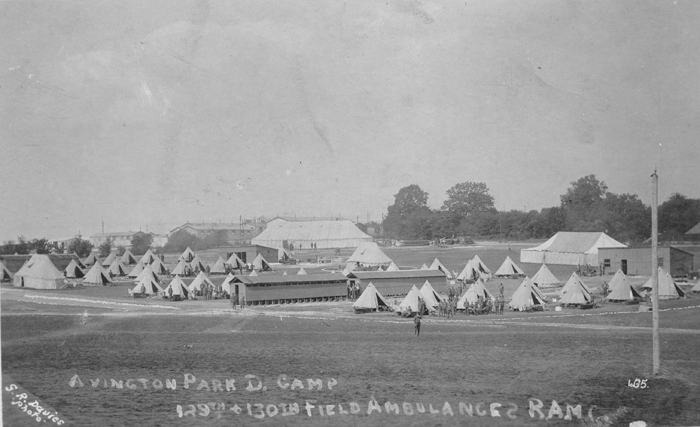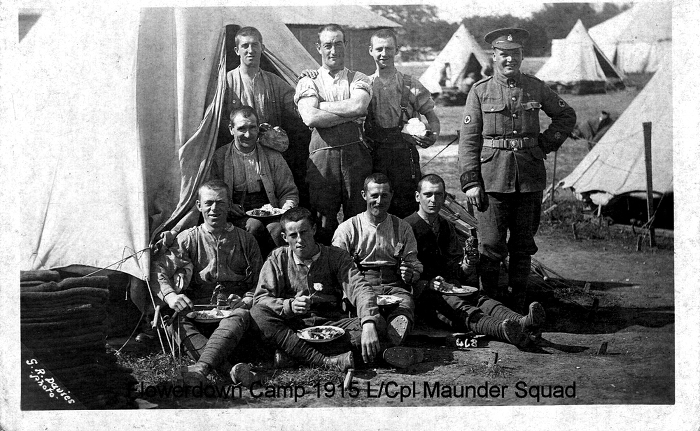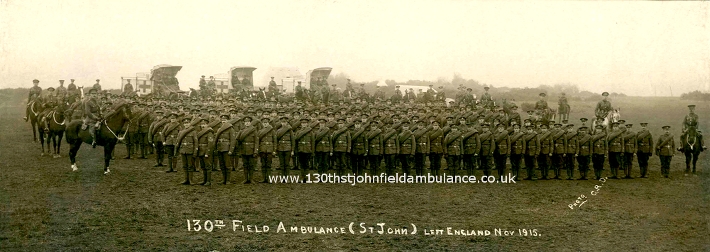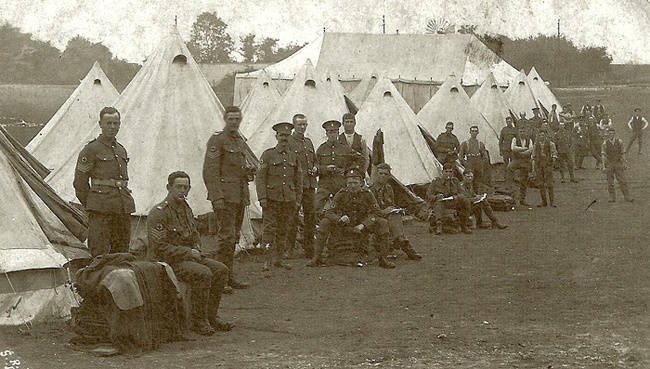Training in Hampshire and Wiltshire August to December 1915
Along with the rest of the 38th (Welsh) Division, the 130th (St John) Field Ambulance moved from North Wales to the Winchester area in Hampshire in mid August 1915. The overnight train journey from Prestatyn lasted 9 hours and the men were marched from Winchester station to Avington Park Camp where the Unit was placed under canvas, co-located with the 129th Field Ambulance. Having to sleep in tents must have come as rather a shock for the men, as up to this time they had been billeted in houses and slept in normal beds, whereas now they slept on wooden boards in circular ‘bell’ tents, 10 men to a tent ( the Sergeants being privileged with only 8 to a tent). By the time they left Wales for Winchester the Unit strength was 257 cap badged R.A.M.C. (7 officers and 250 NCOs and other ranks) with 11 cap badged A/S.C. (1 sergeant and 10 other ranks).

The image above is by courtesy of Winchester City Council Arts and Museums Service
The day that the Unit arrived at Avington Park Camp, the men were left to sort themselves out but, on the following day, training commenced again with reveille at 5.30am, drill from 6.30 to 7.45, further drill and instruction from 9.00am to 1.00pm and 2.00 to 4.30pm, after this the men were free with lights out at 10.00pm.
On Thursday 26th August a 38th (Welsh) Divisional Eisteddfod was held in the Y.M.C.A. tent and the Unit choir was competing but, as they ascended the stage, it suddenly collapsed, which put them off their stride and the prize was won by a choir from one of the other brigades.
On Friday 3rd September, Col Davies took the Unit on a 20 mile route march starting at 8.00am and not returning until 2.00pm. 48128 Sgt Francis B Sumption remarked in his diary ‘the colonel (as usual) lost his way’! The same thing happened on Friday the 17th September with Col Davies getting the Unit back near the starting point at 9.00am after marching only a few miles and so they had to set off again taking a different route.
New recruits continued to arrive from Wales and elsewhere, seeking admission to the Unit. The number of R.A.M.C. men in the Unit increased as did the number of A.S.C. men attached to the Unit and by 13th September, with the Unit now based in Winchester, the number of attached A.S.C. had risen to 1 sergeant and 17 other ranks. Lt T J Buckley reported for duty on 3rd September 1915, bringing the number of officers of the Unit to a total of 8 but by 29th November, this had further increased to 10. While based in the various camps around Winchester, once dismissed for the day, the men were able to travel into Winchester and even Southampton where they attended the cinema or theatre and, very importantly, obtained food to make a change from army cooking. To eat at a table, off a plate with a knife and fork was much more pleasant than eating out of a mess tin squatting on the ground. A favourite dish amongst the men was sausage and mash, known as zeppelin on a cloud.
Towards the end of September, a number of men in the Unit were attached to serve in infantry battalions and artillery batteries of the Division on water duties, being responsible for the water cart and the purification etc of the drinking water for the unit to which they were attached. (This has caused difficulties in identifying these men who joined and trained with the Unit as these men sailed to France with the units to which they were attached and so arrived on dates other than 4th December 1915, so unless other information such as service/pension records or mentions in private papers, we have not been able to identify them and so there are some men missing from the Unit’s nominal roll.
On Friday, the Unit took part in a Divisional field day and as part of the attacking force, wore white bands around their hats. 48128 Sgt Francis B Sumption did not go with the unit as he had to remain at headquarters indenting for medical supplies, but he did record in his diary, “About 5 o’clock our Unit returned, they had been totally annihilated through getting right into the line of fire! I don’t know what will become of us when we get abroad. The way we get on to the wrong track and get cut to pieces is too dreadful to contemplate.”
On the 27th September, the Unit took part in a Divisional march prior to moving to Pitt Corner Camp, a few miles away on the 28th September. A further Divisional route march was held on the 30th September with the various units of the 38th (Welsh) division converging from various directions to march past the General. The Unit marched behind the Pioneers whose mules caused many halts.
At the beginning of October, the men of the Unit moved from sleeping in tents to sheds which in the increasingly wet autumnal weather was a significant improvement for them. A Divisional Field Day was held on the 12th October and the Unit was complimented on their smartness and physique by General Sir Ivor Phillips.
There was an increasing shortage of skilled mechanics, especially within the munitions industry, and an appeal was made to the men of the Division who had such skills to volunteer for this work. On Monday 11th October, these skilled men were called out and marched off to be addressed by Mr A Shirley Benn M.P. and examined by an expert from the Board of Trade who took on only the very skilled workers. Those lost from the Unit in this way could help to explain the some of the numbers in the 48000 series with no medal index card or name.
In his diary, 48072 Sgt John Reeves Davies describes taking a squad of 8 men to the scene of an aeroplane accident near Flower Down Camp, Winchester on the 14th October and 48128 Sgt Francis B Sumption recorded the same event thus; “We had a bit of excitement today; an aeroplane flew over our camp when suddenly it descended with a crash. A squad of our men rushed to the rescue and found the machine smashed to bits and the mechanic suffering badly from shock and concussion. The officer in charge however was not much hurt. We had to guard it during the evening so now the popular gag is ‘Do you know anything about birds? Yes? Then fall out tonight and guard the aeroplane!’.”
Saturday 16th October, the Unit moved to Flowedown camp where now all three of the Field Ambulance units (129th, 130th (St John) and the 131st) of the 38th (Welsh) Division were located and were under canvas again. C section of the Unit was sent to Rollestone Camp on Salisbury Plain (near Stonehenge) to form an observation Hospital for the 113rd & 115th Brigades of the 38th (Welsh) Division, who were there for rifle practice. Here they were placed in canvas huts which Sgt Davies describes as being in a disgraceful state. They constructed a Hospital to accommodate 8 beds, with a Pack store, waiting and dispensary room and their arrangements were complimented by Col Russell RAMC. The 113rd Brigade left Salisbury Plain on the 24th October and were replaced by the 115th Brigade. By the 26th October , the Hospital was full, but Lieut T J Buckley along with 48586 Cpl T J Jones, 48559 LCpl T J Nicholas, and 48560 Pte T J Oldham returned back to Winchester by motor car to play in a football match for the Divisional Cup tie (no result is given). Both Cpl Jones and LCpl Nicholas were later awarded the Military Medal (MM) for acts of gallantry performed during the Unit’s time in France and Pte Oldham, who subsequently transferred to the Royal Engineers, was wounded in 1918.

Photograph by kind permission of Ray Maunder, son of 48160 L/Cpl William H F Maunder
As October progressed, the men were issued with active service clothes and an increasing number of men were granted short leave passes.
C section returned to Flower Down Camp near Winchester on the 4th November and the whole Unit was inspected on the 23rd November by Mr Herbert Lewis (the Deputy Commissioner of the St John Ambulance Association in Wales who had originally mobilised the Unit in 1914). A Divisional Bivouac on Crawley Warren was held on the 25th November and on the following day a Divisional March-past and inspection by General Sir Ivor Phillips took place.

The photograph above is by kind permission of Charles Young, Grandson of 48221 Pte Oliver Young M.M.. It was probably taken on the 26th November when there was a Divisional March Past in preparation for the Royal Inspection by Queen Mary on the 29th November 1915.
The entire 38th (Welsh) Division was inspected by Queen Mary on behalf of the King on a cold and wet 29th November and a short, silent move clip of this visit can be viewed on the
“http://www.britishpathe.com/video/queen-mary-inspects-troops-1/query/Queen+Mary+inspects” Queen Mary inspects the 38th (Welsh) Division 29th November 1915″ British Pathe website
48128 Sgt Francis B Sumption wrote of the day in a letter home. “The great day is over at last and a terrible time we had. We were up at 5.30am and were soon shaving and polishing up. After breakfast we paraded at 7.45am and started off for the parade ground at 8.00am. We wore our coats rolled around us bandolier fashion although it was raining. We reached the ground at 9 o’clock nearly drenched and stood there in the rain for about three hours and the rain got through to the skin. We were then told to put on our coats. When the Queen arrived we took off our coats, put on our equipment and commenced to move around the course past the Queen with our eyes going ‘right’ with ‘a click’ and then went back to our stand. We waited for 3/4 hour for our tea to be made and drank it from our mess tins together with a hunk of bread and cheese. I can tell you it went down very sweetly as we were all cold and ravenously hungry. Marched back through the slush into the deeper slush of the camp and tried our best to dry our clothes. Slept like a top and am only a little foot sore as a result of yesterday’s performance”.
It continued to rain almost non stop for several days before turning very cold and frosty, making life under canvas very unpleasant although it was a little better for the Sergeants who had a wooden hut as a Mess. Much time was spent in organising the mobilisation equipment for the Unit. Everything from the large wicker hampers of medical equipment to horse harnesses. In fact everything that a Field Ambulance needed for active service.

The men of the Unit sanitary squad were becoming unhappy as they disliked being called the “shit wallopers” by the other men in the Unit.
On Monday 8th November, the men of the Unit were issued with their identity discs, small leather identity discs to wear around their necks with their name, number and religion stamped on them. The men referred to them as “death discs”.
In mid November the men were granted their last leave, single men getting 3 days and married men 4. Not long to travel back to Wales to see their families, or even further afield for some in the Unit.
Not all the men who had originally joined the Unit back in December 1914 sailed to France with the Unit on the 3rd December 1915. Some were found unfit for military service (these are the Regimental Numbers with no medal index cards) and others such as 48231 Pte Thomas William Jones were sick and admitted to hospital. 48231 Pte Thomas William Jones was admitted to hospital on the 3rd November (the hand writing on his pension record is difficult to decipher but may read ‘epididymitis (tuberculous)’ and remained there until 10th March 1916 and was subsequently discharged from the Army on the 26th March 1916 and awarded a Silver War Badge.
On the 3rd December the Unit was up early with reveille at 3.30am, spent between 4.00 and 5.00am loading the wagons with their kit before having breakfast. With all their plates etc packed away they had to manage as best they could. At 6.00am the Unit commenced their march of some 18 miles to Southampton in the pouring rain. There was a short stop midway when the men were served with tea at a house on the wayside and, as they entered Southampton cold and drenched, ladies from a Soldier’s home gave the men hot coffee and sandwiches. They arrived at the dock at lunchtime but had to wait before finally boarding the SS Karnak (described by 48128 Sgt F B Sumption as a “filthy tramp steamer”) at 4.10pm. The 130th (St John) Ambulance War Diary records that the Unit that sailed from Southampton to Le Havre consisted of 230 all ranks. The SS Karnak set sail at 5.00pm. The 130th (St John) Field Ambulance was off to war.
